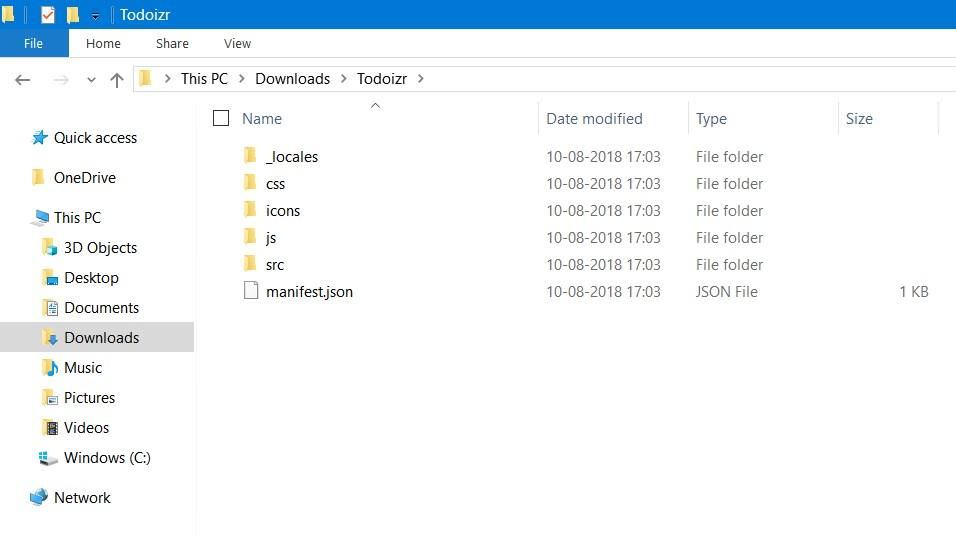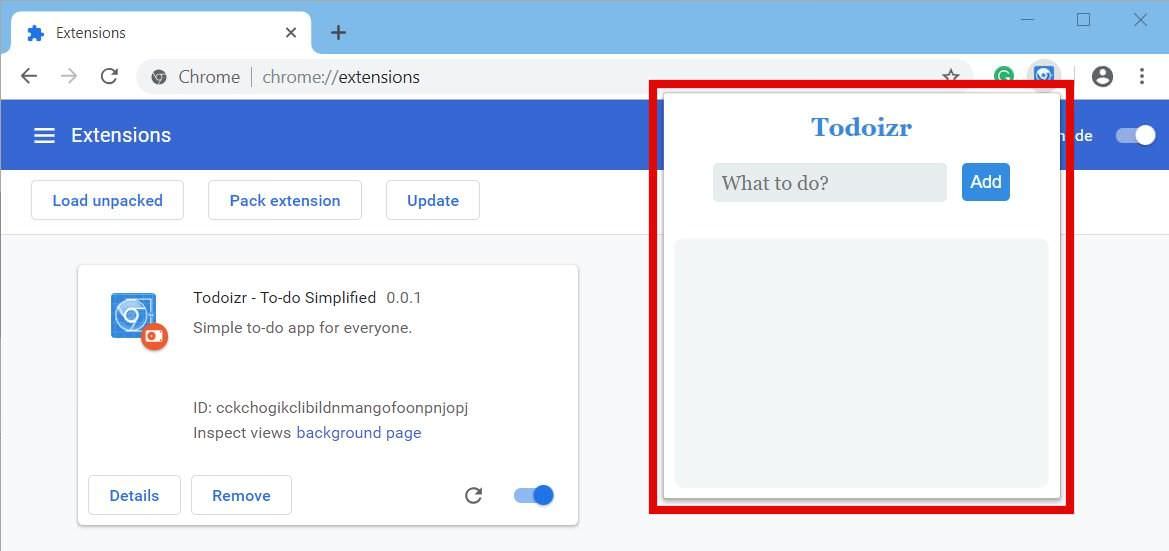Step 2. Code the extension
After you’ve downloaded and extracted the template, you’ll see a directory structure as shown in the below screenshot. The template is neatly organized, and you must know that the most important file is “manifest.json“.


Let’s get to know other files and folders in this directory as well:
- _locales: It is used to store language information for a multilingual app.
- css: It functions to store third-party front-end libraries like Bootstrap.
- icons: It is designed to have icons for your extension in varied sizes.
- js: It comes handy to save third-party back-end libraries like jQuery.
- src: It stores the actual code that you will write for your extension.
manifest.json
It contains the basic metadata about your app, which defines your app’s details to the browser. You can edit it to set your extension’s name, description, website, icon, etc. along with specifics like browser actions and permissions.
For example, in the below code, you’ll notice that I changed the name, description, and homepage_url along with default_title under browser_action. Moreover, I added “storage” under permissions as we need to store data in our extension.
{
"name": "Todoizr - To-do Simplified",
"version": "0.0.1",
"manifest_version": 2,
"description": "Simple to-do app for everyone.",
"homepage_url": "https://go.aksingh.net/todoizr",
"icons": {
"16": "icons/icon16.png",
"48": "icons/icon48.png",
"128": "icons/icon128.png"
},
"default_locale": "en",
"browser_action": {
"default_icon": "icons/icon19.png",
"default_title": "Todoizr - To-do Simplified",
"default_popup": "src/browser_action/browser_action.html"
},
"permissions": [
"storage"
]
}
src\browser_action
This directory will hold the code for browser action. In our case, we will code the popup window shown at clicking the extension’s icon in the browser. Our extension will allow users to add and view to-do items in the popup.
Initial code from the template
Though this directory had just an HTML file having all the code, I have decided to divide it into three separate files for better clarity. That said, the HTML file named “browser_action.html” now has the following code:
<!doctype html> <html> <head> <link rel="stylesheet" href="./browser_action.css"/> </head> <body> <div id="mainPopup"> </div> <script type="text/javascript" src="./browser_action.js"></script> </body> </html>
Moreover, the style file named “browser_action.css” has the below content while the JavaScript file named “browser_action.js” is blank for now.
#mainPopup {
padding: 10px;
height: 200px;
width: 400px;
font-family: Helvetica, Ubuntu, Arial, sans-serif;
}
h1 {
font-size: 2em;
}
Design the popup’s interface
After setting up the initial project, let’s first design the interface of the popup. I have set up the interface with a minimalistic approach, showing the name at the top followed by a form to add to-do items and an area below for viewing the added items. It is inspired by the simplistic design of “Form Style 5“.


In the code below, I have added two divs – one for displaying the form to add a to-do item and the other one for displaying the list of already added to-do items. That said, the new code for “browser_action.html” is as follows:
<!doctype html>
<html>
<head>
<link rel="stylesheet" href="./browser_action.css"/>
</head>
<body>
<div id="mainPopup">
<!-- To-do item form -->
<div class="form-style-5" id="form">
<h1>Todoizr</h1>
<form>
<fieldset>
<input type="text" name="todo" placeholder="What to do?" id="txt">
<input type="button" value="Add" id="btn" />
</fieldset>
</form>
</div>
<!-- To-do item list -->
<div class="form-style-5">
<ul id="list">
</ul>
</div>
</div>
<script type="text/javascript" src="./browser_action.js"></script>
</body>
</html>
And the style file “browser_action.css” now has the following code:
@import url("./form_style_5.css");
#mainPopup {
height: 200px;
width: 300px;
font-family: Helvetica, Ubuntu, Arial, sans-serif;
}
/* To-do item form */
.form-style-5 {
margin: auto;
padding: 0px 20px;
}
.form-style-5:first-child {
background: none;
}
.form-style-5 h1 {
color: #308ce3;
font-size: 20px;
text-align: center;
}
.form-style-5 input[type="text"] {
width: auto;
float: left;
margin-bottom: unset;
}
.form-style-5 input[type="button"] {
background: #308ce3;
width: auto;
float: right;
padding: 7px;
border: none;
border-radius: 4px;
font-size: 14px;
}
.form-style-5 input[type="button"]:hover {
background: #3868d5;
}
/* To-do item list */
.form-style-5:last-child {
height: inherit;
margin-bottom: 5px;
}
.form-style-5 ul {
padding: 20px;
}
.form-style-5 ul li {
font-size: 14px;
}
Lastly, the third-party style file “form_style_5.css” has the below content. It is simply taken from its website to inspire the design of our extension.
/* Form Style 5 by Sanwebe.com */
/* https://www.sanwebe.com/2014/08/css-html-forms-designs */
.form-style-5{
max-width: 500px;
padding: 10px 20px;
background: #f4f7f8;
margin: 10px auto;
padding: 20px;
background: #f4f7f8;
border-radius: 8px;
font-family: Georgia, "Times New Roman", Times, serif;
}
.form-style-5 fieldset{
border: none;
}
.form-style-5 legend {
font-size: 1.4em;
margin-bottom: 10px;
}
.form-style-5 label {
display: block;
margin-bottom: 8px;
}
.form-style-5 input[type="text"],
.form-style-5 input[type="date"],
.form-style-5 input[type="datetime"],
.form-style-5 input[type="email"],
.form-style-5 input[type="number"],
.form-style-5 input[type="search"],
.form-style-5 input[type="time"],
.form-style-5 input[type="url"],
.form-style-5 textarea,
.form-style-5 select {
font-family: Georgia, "Times New Roman", Times, serif;
background: rgba(255,255,255,.1);
border: none;
border-radius: 4px;
font-size: 16px;
margin: 0;
outline: 0;
padding: 7px;
width: 100%;
box-sizing: border-box;
-webkit-box-sizing: border-box;
-moz-box-sizing: border-box;
background-color: #e8eeef;
color:#8a97a0;
-webkit-box-shadow: 0 1px 0 rgba(0,0,0,0.03) inset;
box-shadow: 0 1px 0 rgba(0,0,0,0.03) inset;
margin-bottom: 30px;
}
.form-style-5 input[type="text"]:focus,
.form-style-5 input[type="date"]:focus,
.form-style-5 input[type="datetime"]:focus,
.form-style-5 input[type="email"]:focus,
.form-style-5 input[type="number"]:focus,
.form-style-5 input[type="search"]:focus,
.form-style-5 input[type="time"]:focus,
.form-style-5 input[type="url"]:focus,
.form-style-5 textarea:focus,
.form-style-5 select:focus{
background: #d2d9dd;
}
.form-style-5 select{
-webkit-appearance: menulist-button;
height:35px;
}
.form-style-5 .number {
background: #1abc9c;
color: #fff;
height: 30px;
width: 30px;
display: inline-block;
font-size: 0.8em;
margin-right: 4px;
line-height: 30px;
text-align: center;
text-shadow: 0 1px 0 rgba(255,255,255,0.2);
border-radius: 15px 15px 15px 0px;
}
.form-style-5 input[type="submit"],
.form-style-5 input[type="button"]
{
position: relative;
display: block;
padding: 19px 39px 18px 39px;
color: #FFF;
margin: 0 auto;
background: #1abc9c;
font-size: 18px;
text-align: center;
font-style: normal;
width: 100%;
border: 1px solid #16a085;
border-width: 1px 1px 3px;
margin-bottom: 10px;
}
.form-style-5 input[type="submit"]:hover,
.form-style-5 input[type="button"]:hover
{
background: #109177;
}
Write the popup’s logic
Once we are done with the extension’s front-end, let’s now write the logic for its working. We need our extension to be able to add to-do items and also display them in the popup window. So we will add a button click listener to add the input text as a to-do item and a page load listener to show those items.
In the code below, we are going to use two functions — sync.get() and sync.set(), which are part of “chrome.storage“. We need the second one to save the to-do items in the storage and the first one to retrieve them and show them.
That said, below is the final code of the “browser_action.js” file. As you can see below, the code is highly commented to help you understand its purpose.
function loadItems() {
/* First get() the data from the storage */
chrome.storage.sync.get(['todo'], function(result) {
var todo = []
if (result && result.todo && result.todo.trim() !== '') {
/* Parse and get the array as it is saved as a string */
todo = JSON.parse(result.todo)
}
console.log('todo.length = ' + todo.length)
for (var i = 0; i < todo.length; i++) {
item = todo[i]
if (item && item.trim() !== '') {
/* Append the items in the #list for showing them */
var list = document.getElementById('list')
var entry = document.createElement('li')
var text = document.createTextNode(item)
entry.appendChild(text)
list.appendChild(entry)
}
}
})
}
/* Load the to-do items upon popup load */
document.addEventListener('DOMContentLoaded', function(){
console.log('Inside doc.loaded()')
loadItems()
})
/* Save the to-do item upon button click */
document.getElementById('btn').addEventListener('click', function (ev) {
console.log('Inside btn.click()')
text = document.getElementById('txt').value
if (text && text.trim() !== '') {
/* First get() old data as calling set() will replace it */
chrome.storage.sync.get(['todo'], function(result) {
var todo = []
if (result && result.todo && result.todo.trim() !== '') {
/* Parse and get the array as it is saved as a string */
todo = JSON.parse(result.todo)
}
todo.push(text)
chrome.storage.sync.set({'todo': JSON.stringify(todo)}, function() {
/* Data is saved now */
var list = document.getElementById('list')
while (list.firstChild) {
list.removeChild(list.firstChild)
}
loadItems()
})
})
}
})